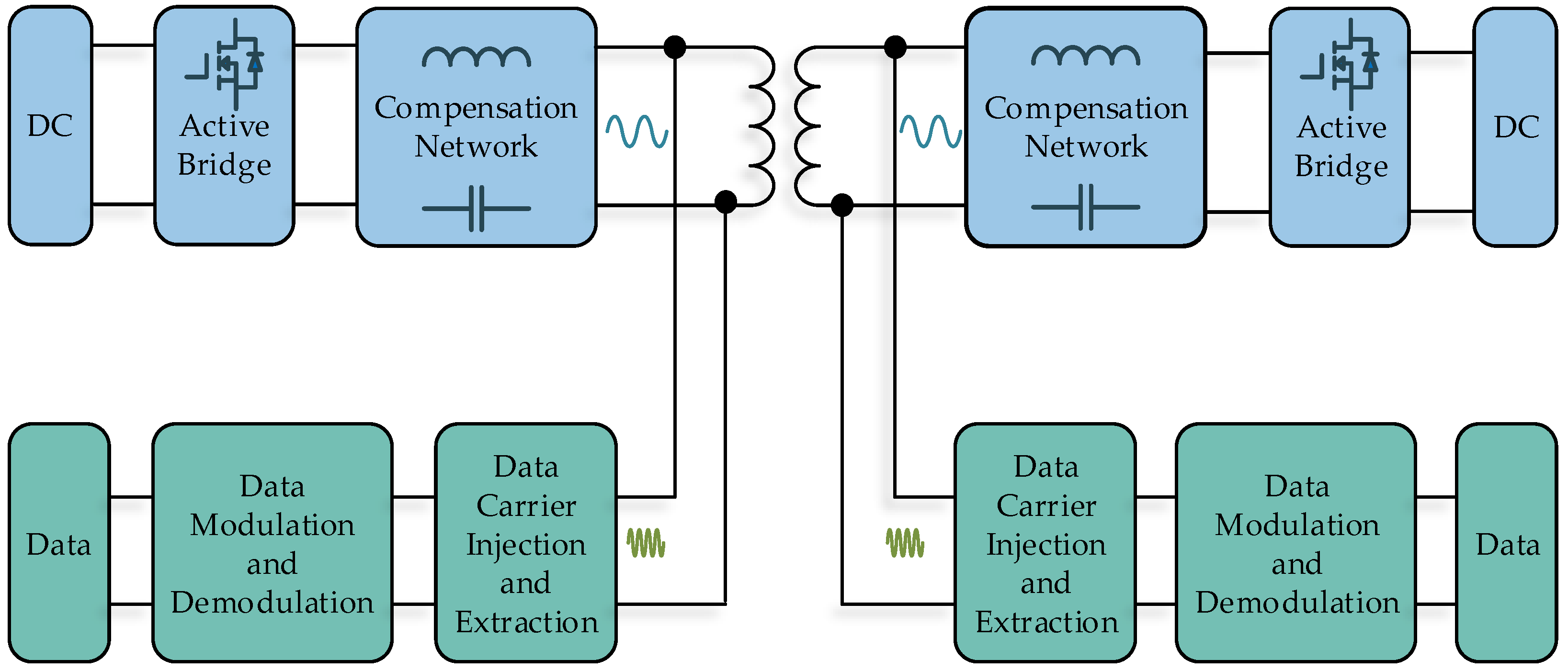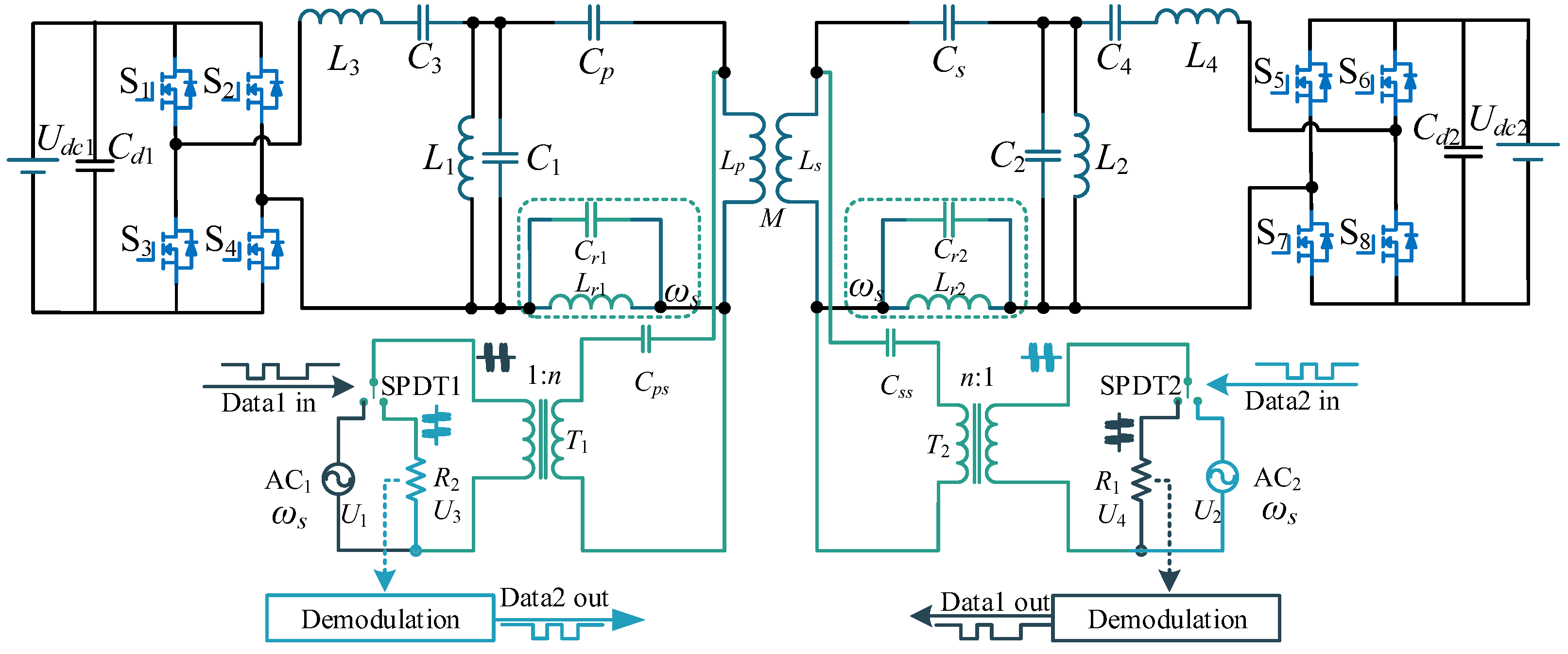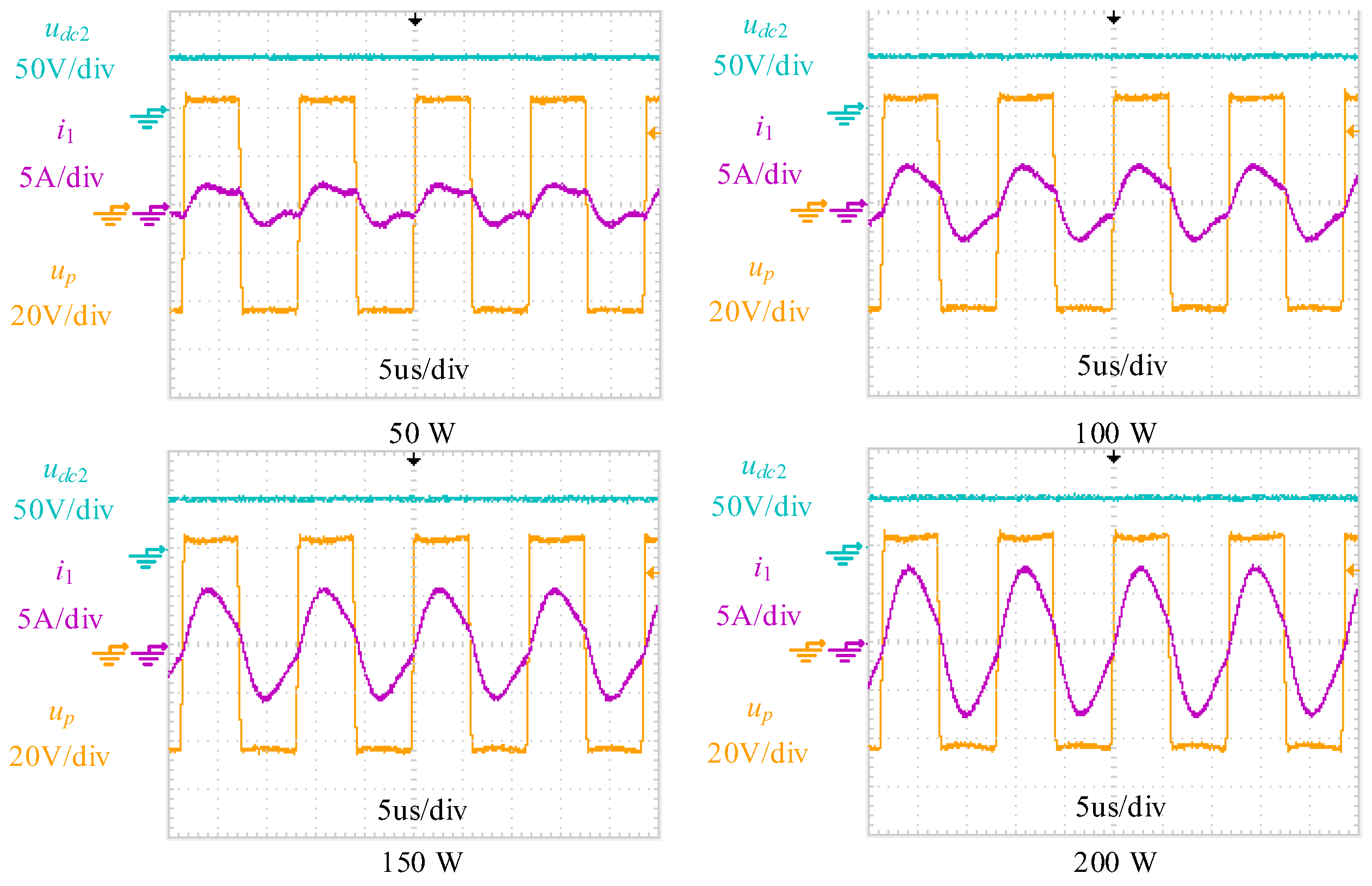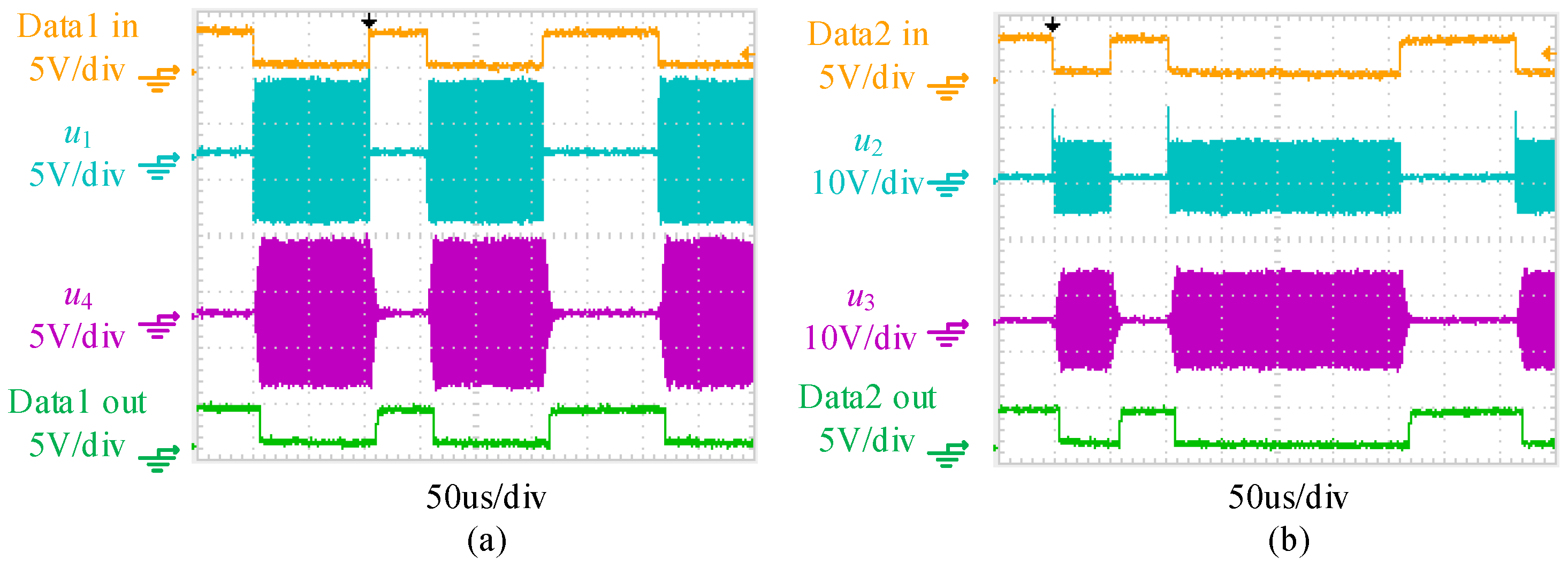A Bidirectional Simultaneous Wireless Power and Data Transfer System with Non-Contact Slip Ring
Abstract
:1. Introduction
- (1)
- Simultaneous wireless power and data transfer through a pair of coupled coils;
- (2)
- An on-contact slip ring based on a caliper-type coupling structure is utilized to replace the traditional contact slip ring equivalently;
- (3)
- Bidirectional power transfer with independent transfer gains is achieved;
- (4)
- A constant-voltage output topology with band-pass filtering characteristics is proposed, achieving constant voltage output and suppressing the power interference on simultaneous data transfer.
2. System Overview
3. Bidirectional Power Transfer Channel
3.1. The Topology of the Power Transfer Channel
3.2. The Caliper Type Coupler
4. Bidirectional Data Transfer Channel
5. Experimental Verification
6. Results and Discussion
7. Conclusions
Author Contributions
Funding
Data Availability Statement
Conflicts of Interest
References
- Deng, P.; Tang, C.; Sun, M.; Liu, Z.; Hu, H.; Lin, T. EMI Suppression Method for LCC-S MC-WPT Systems by Parameter Optimization. IEEE Trans. Power Electron. 2024, 39, 11134–11147. [Google Scholar] [CrossRef]
- Sun, Y.; Liao, Z.-J.; Ye, Z.-H.; Tang, C.-S.; Wang, P.-Y. Determining the Maximum Power Transfer Points for MC-WPT Systems with Arbitrary Number of Coils. IEEE Trans. Power Electron. 2018, 33, 9734–9743. [Google Scholar] [CrossRef]
- Zhang, Z.; Georgiadis, A.; Cecati, C. Wireless Power Transfer for Smart Industrial and Home Applications. IEEE Trans. Ind. Electron. 2019, 66, 3959–3962. [Google Scholar] [CrossRef]
- Lee, C.-H.; Ho, S.-T.; Hsu, S.-H.; Jiang, J.-A. Taguchi-Based Design of Planar Circular Coils Used in Wireless Charging of Mobile Phones. IEEE Trans. Consum. Electron. 2024, 70, 299–307. [Google Scholar] [CrossRef]
- Deng, Z.; Hu, H.; Su, Y.; Chen, F.; Xiao, J.; Tang, C.; Lin, T. Design of a 60-kW EV Dynamic Wireless Power Transfer System with Dual Transmitters and Dual Receivers. IEEE J. Emerg. Sel. Top. Power Electron. 2024, 12, 316–327. [Google Scholar] [CrossRef]
- Zhu, J.; Barmada, S.; Musolino, A.; Sani, L. Maintain Power Transmission and Efficiency Tracking Using Variable Capacitors for Dynamic WPT Systems. Electronics 2024, 13, 2853. [Google Scholar] [CrossRef]
- Shah, I.A.; Zada, M.; Shah, S.A.A.; Basir, A.; Yoo, H. Flexible Metasurface-Coupled Efficient Wireless Power Transfer System for Implantable Devices. IEEE Trans. Microw. Theory Tech. 2024, 72, 2534–2547. [Google Scholar] [CrossRef]
- Fernandez-Munoz, M.; Missous, M.; Sadeghi, M.; Lopez-Espi, P.L.; Sanchez-Montero, R.; Martinez-Rojas, J.A.; Diez-Jimenez, E. Fully Integrated Miniaturized Wireless Power Transfer Rectenna for Medical Applications Tested inside Biological Tissues. Electronics 2024, 13, 3159. [Google Scholar] [CrossRef]
- Chen, C.; Jiang, C.; Wang, Y.; Fan, Y.; Luo, B.; Cheng, Y. Compact Curved Coupler With Novel Flexible Nanocrystalline Flake Ribbon Core for Autonomous Underwater Vehicles. IEEE Trans. Power Electron. 2024, 39, 53–57. [Google Scholar] [CrossRef]
- Feng, Y.; Sun, Y.; Lin, T.; Hu, H.; Chen, F. Mutual inductance surrogate model of the UWPT system and its constant power optimization at misaligned positions. Wirel. Power Transf. 2024, 11, e001. [Google Scholar] [CrossRef]
- Meng, W.; Hu, N.; Lan, H.; Lv, T. Lightweight Design of Magnetic Coupling Mechanism of Wireless Power Transfer System for Underground Rotary Guidance Device. In Proceedings of the 2024 10th International Conference on Power Electronics Systems and Applications (PESA), Hong Kong, China, 5–7 June 2024; pp. 1–4. [Google Scholar] [CrossRef]
- Song, K.; Ma, B.; Yang, G.; Jiang, J.; Wei, R.; Zhang, H.; Zhu, C. A Rotation-Lightweight Wireless Power Transfer System for Solar Wing Driving. IEEE Trans. Power Electron. 2019, 34, 8816–8830. [Google Scholar] [CrossRef]
- Zhou, Y.; Luo, Y.; Liu, S.; Li, D. An Efficient and Stable Embedded Multi-U-Shaped Column Rotary Transformer. IEEE Trans. Power Electron. 2023, 38, 6734–6743. [Google Scholar] [CrossRef]
- Wang, L.; Li, J.; Luo, G.; Si, Q.; Guo, Z.; Peng, Y.; Robertson, I. A Mixed Flux Coupler and Dual-Path Parallel Compensation Based Rotating Wireless Power Transfer System Integrated with Rotational Speed Monitoring Function. IEEE Trans. Power Electron. 2024, 39, 7736–7751. [Google Scholar] [CrossRef]
- He, X.; Shu, W.; Yu, B.; Ma, X. Wireless Power Transfer System for Rotary Parts Telemetry of Gas Turbine Engine. Electronics 2018, 7, 58. [Google Scholar] [CrossRef]
- Trevisan, R.; Costanzo, A. A 1-kW contactless energy transfer system based on a rotary transformer for sealing rollers. IEEE Trans. Ind. Electron. 2014, 61, 6337–6345. [Google Scholar] [CrossRef]
- Zhang, Y.; Yang, J.; Jiang, D.; Li, D.; Qu, R. Design, Manufacture, and Test of a Rotary Transformer for Contactless Power Transfer System. IEEE Trans. Magn. 2022, 58, 8400206. [Google Scholar] [CrossRef]
- Li, T.; Wang, Y.; Lang, Z.; Qi, C.; Jin, X.; Chen, X.; Xu, D. Analysis and Design of Rotary Wireless Power Transfer System with Dual-Coupled XLC/S Compensation Topology. IEEE Trans. Ind. Appl. 2023, 59, 2639–2649. [Google Scholar] [CrossRef]
- Fan, Y.; Hu, H.; Sun, Y.; Hu, H.; Wu, S. A Simultaneous Wireless Power and Coil Inductance Insensitive Data Transfer System for Rotary Structures. IEEE Trans. Power Electron. 2024, 39, 6526–6536. [Google Scholar] [CrossRef]
- Li, X.; Li, Z.; Madawala, U.K.; Wang, H.; Sun, Y.; Dai, X.; Hu, J. A Simultaneous Wireless Power and Data Transfer Method Utilizing a Novel Coupler Design for Rotary Steerable Systems. IEEE Trans. Power Electron. 2024, 39, 11824–11833. [Google Scholar] [CrossRef]
- Sun, Y.; Yan, P.-X.; Wang, Z.-H.; Luan, Y.-Y. The Parallel Transmission of Power and Data with the Shared Channel for an Inductive Power Transfer System. IEEE Trans. Power Electron. 2016, 31, 5495–5502. [Google Scholar] [CrossRef]



















| Symbols | Unit | Value |
|---|---|---|
| Air gap d | mm | 10 |
| Inner ring turns ns | Turns | 15 |
| Outer ring turns | Turns | 15 |
| Outer ring curvature | Degree | 90 |
| Symbols | Unit | Values | Symbols | Unit | Values |
|---|---|---|---|---|---|
| Udc | V | 48 | fs | kHz | 1500 |
| ff | kHz | 85 | fr | kHz | 105 |
| Lp | μH | 59 | Ls | μH | 109 |
| M | μH | 27.75 | n | -- | 5 |
| L1 | μH | 9.5 | L2 | μH | 14.5 |
| C1 | nF | 241 | C2 | nF | 241 |
| L3 | μH | 30 | L4 | μH | 35 |
| C3 | nF | 61 | C4 | nF | 285 |
| Cp | nF | 34.5 | Cs | nF | 23.7 |
| Lr1 | μH | 15 | Lr2 | μH | 15 |
| Cr1 | pF | 750 | Cr2 | pF | 750 |
| Cps | pF | 219 | Css | pF | 118 |
| References | [12] | [15] | [16] | [19] | [20] | [21] | This Work |
|---|---|---|---|---|---|---|---|
| Data Transfer | N/A | N/A | N/A | Y | Y | Y | Y |
| Coupler Type | Coaxial Nested | Planar | Can type | Coaxial Nested | Coaxial Nested | Coaxial Nested | Caliper type |
| Maintenance Flexibility | Medium | High | High | Medium | Medium | Medium | High |
| Power Transfer | Unidirectional | Unidirectional | Unidirectional | Unidirectional | Unidirectional | Unidirectional | Bidirectional |
| Channels | 1 | 1 | 1 | 2 (Shared) | 2 (Separate) | 2 (Shared) | 2 (Shared) |
| Harmonic Filtering | N/A | N/A | N/A | Y | N/A | N/A | Y |
Disclaimer/Publisher’s Note: The statements, opinions and data contained in all publications are solely those of the individual author(s) and contributor(s) and not of MDPI and/or the editor(s). MDPI and/or the editor(s) disclaim responsibility for any injury to people or property resulting from any ideas, methods, instructions or products referred to in the content. |
© 2024 by the authors. Licensee MDPI, Basel, Switzerland. This article is an open access article distributed under the terms and conditions of the Creative Commons Attribution (CC BY) license (https://creativecommons.org/licenses/by/4.0/).
Share and Cite
Fan, Y.; Chen, Q.; Wu, S.; Xiao, J.; Wang, Z. A Bidirectional Simultaneous Wireless Power and Data Transfer System with Non-Contact Slip Ring. Electronics 2024, 13, 3974. https://doi.org/10.3390/electronics13203974
Fan Y, Chen Q, Wu S, Xiao J, Wang Z. A Bidirectional Simultaneous Wireless Power and Data Transfer System with Non-Contact Slip Ring. Electronics. 2024; 13(20):3974. https://doi.org/10.3390/electronics13203974
Chicago/Turabian StyleFan, Yuanshuang, Qiurui Chen, Sihan Wu, Jing Xiao, and Zhihui Wang. 2024. "A Bidirectional Simultaneous Wireless Power and Data Transfer System with Non-Contact Slip Ring" Electronics 13, no. 20: 3974. https://doi.org/10.3390/electronics13203974





